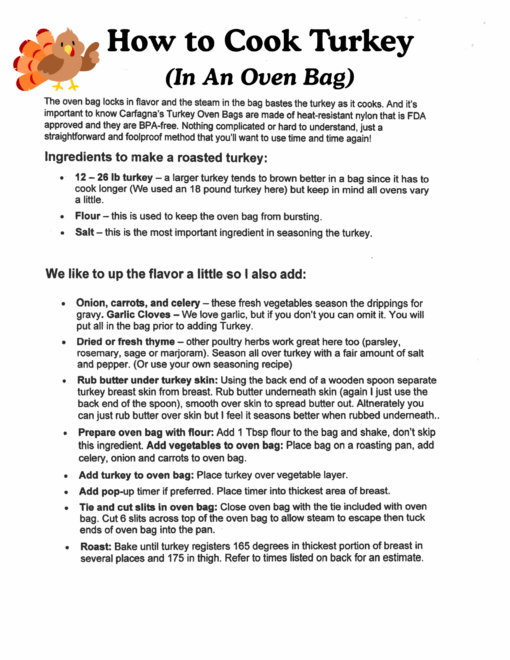
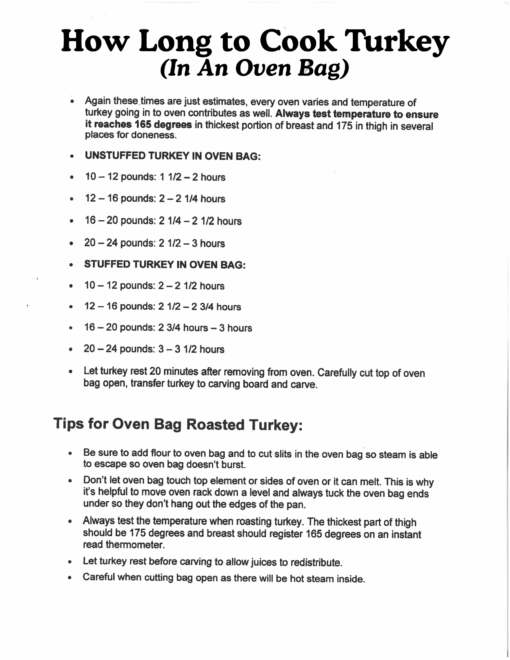
Book Your Table!
This Week's Specials!
Explore Our Online Store
The Gift of Carfagna!


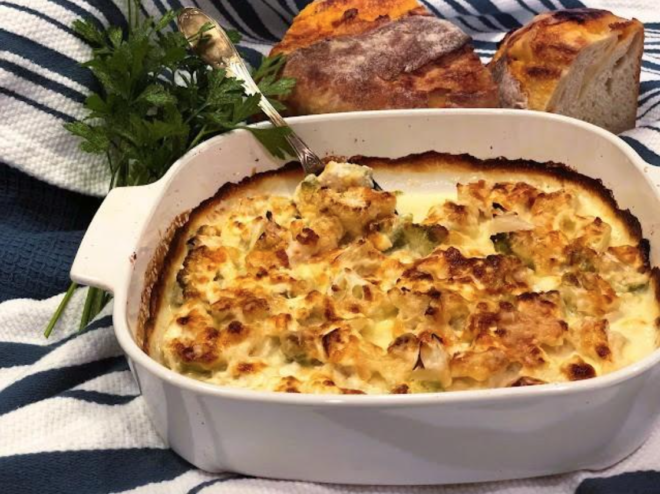
This simple recipe features three cheeses from Carfagna’s award winning cheese shop! We have chosen mascarpone, fontina, and Parmigiano for the gratin. You could switch up the cheeses, just be sure to use a creamy style cheese, plus a good melting cheese, and a sharp cheese to get the right balance of texture and flavor. Serve the gratin with a green salad and a simple piece of sautéed fish or chicken.
Preheat the oven to 400 degrees.
Drizzle the olive oil evenly over the bottom of a medium size gratin dish. Place the cauliflower florets, or potatoes, into the casserole dish, spreading out into an even layer. Pour in the cream. Crumble and scatter the mascarpone cheese over the florets, along with the fontina and Parmesan cheese. Sprinkle the salt and pepper evenly over the top.
Place the casserole dish into the hot oven, roasting for 30 minutes until the cauliflower is tender and the sauce has slightly thickened. Remove from the oven, resting for 10 minutes before serving. Garnish with fresh basil leaves.
Featured Market Ingredients
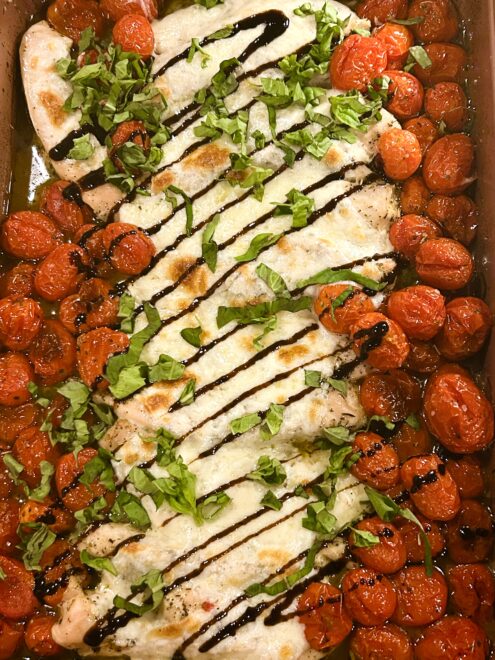
Caprese Salad has a long history dating back to the 1920’s having originated on the Island of Capri, always including juicy ripe tomatoes, mozzarella cheese, and fresh basil leaves. Modern times have brought forward variations of the caprese ingredients such as this Sheet Pan Chicken Caprese recently made by a team of students attending class in Carfagna’s Cooking School. Just one of the many creative dishes featured in our classes. Click here for more information.
Preheat the oven to 425 degrees. Working with a 9”x13” rimmed baking sheet, drizzle 1 tablespoon olive oil, using you hands to evenly coat the bottom of the pan. Add the cherry tomatoes, sprinkle the Italian seasoning and 1 teaspoon salt over the tomatoes, shaking the pan to coat the tomatoes in the oil and seasoning.
Evenly place the chicken breasts in the center of the pan in a single layer, pushing the cherry tomatoes to the perimeter of the pan. Drizzle the chicken with the remaining tablespoon of oil, sprinkling the remaining teaspoon of salt over the chicken. Place the sheet pan into the hot oven, baking for 20-25 minutes until the chicken is nearly cooked through to 150-155 degrees and the tomatoes have slumped and started to burst. Remove the sheet pan from the oven. Turn the oven onto the Broiler setting. The chicken will continue cooking in the next step.
Carefully place a slice of mozzarella over each chicken breast. Return the pan to the oven, placing it on the center rack, not too close to the broiler. Allow the mozzarella cheese to slowly bubble and slightly brown from the heat of the broiler, about 5-7 minutes. Remove the pan from the oven. Drizzle the chicken and tomatoes with balsamic glaze, garnishing with the torn basil leaves.
Featured Market Ingredients
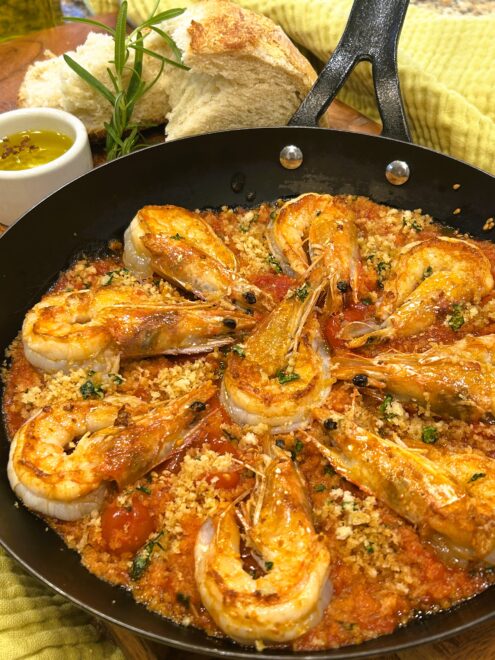
From the coast of Veneto, Italy, gamberi alla busara is a dish of whole shell-on prawns in a garlicky tomato sauce spiked with white wine. The dish takes its name from the Venetian word “busara,” which refers to a large pan used to cook seafood over an open flame. The combination of shrimp, cherry tomatoes, garlic, and herbs creates a delicious sauce that will transport you straight to the sunny shores of the Mediterranean coast. Be sure to have some great bread on hand for dipping into the sauce.
In a 12-inch non-stick skillet over medium-high heat, heat 2 tablespoons olive oil until shimmering. Add in the panko breadcrumbs and 1/2 teaspoon salt, cooking, stirring often, until the breadcrumbs are golden brown, about 4-5 minutes. Transfer to a small bowl, adding in 2 tablespoons of chopped parsley, stirring to combine. Set aside.
Place the peeled and deveined shrimp onto paper towels, patting to dry the shrimp. Season with 1/2 teaspoon salt.
In the same skillet over medium-high heat, add 2 tablespoons olive oil, heating until shimmering. Carefully place the shrimp into the pan in a single layer, cooking on this side for 4-5 minutes until the cooked side is well browned. Do not cook on the second side at this point. Remove the shrimp from the pan placing onto a plate. The shrimp is not fully cooked at this point and will finish cooking in the sauce.
In the same skillet over medium-high heat, add the remaining tablespoon of olive oil. Add the garlic, shallots, and red pepper flakes, stirring and cooking for 30 seconds. Add in the white wine, cooking and stirring until the wine is nearly evaporated, about 3-4 minutes. Add the cherry tomatoes and the juices from the can along with the remaining chopped parsley, and remaining 1 teaspoon salt, cooking until the mixture is slightly thickened, about 5-6 minutes. Some of the cherry tomatoes may burst as you are stirring, which will add to the flavor of the sauce. Add the shrimp, and any collected juices, to the sauce to cook through, cooking for about 1-2 minutes. Transfer the shrimp and sauce to a large serving platter, sprinkling with the toasted breadcrumbs.
Featured Market Ingredients
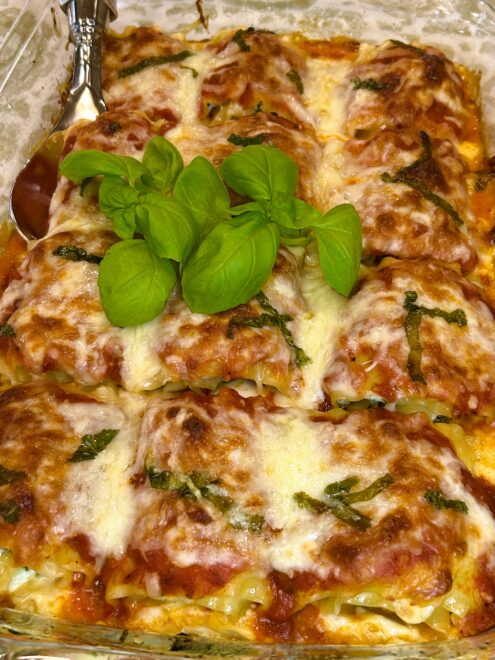
Lasagna is always a crowd pleaser. Layers of creamy, cheesy, pasta and sauce, cooked to melted perfection. In this recipe, classic lasagna gets an update by skipping the layers, and instead filling and rolling the lasagna sheets. Perfect for creating portions and easy serving for your next gathering.
This recipe uses three cheeses, ricotta, Parmesan, and mozzarella, folded together with chopped spinach, baked on a bed of creamy bechamel sauce, and topped with traditional marinara sauce. Perfect at a buffet table, or as a family supper served with seared chicken or Italian sausage links to accompany the lasagna rolls.
For the Bechamel Sauce
For the Lasagna Rolls
Make the Bechamel Sauce:
In a small saucepan, melt the butter over medium-low heat. Add in the flour, whisking for 3 minutes. Whisk in the milk, increasing the heat to medium-high, whisking until the sauce becomes thick, smooth and bubbly, about 5-6 minutes. Turn off the heat, whisk in the salt, pepper, and nutmeg. Set aside.
Make the Lasagna Rolls:
Follow the package directions to par-boil the lasagna sheets in salted water, boiling for half of the instructed time. The pasta should be just tender and still firm to bite. Remove the sheets from the water, placing in a single layer onto a parchment lined baking sheet, drizzled with olive oil to prevent the sheets from sticking. You will need to create 2-3 single layers to keep the sheets from sticking using parchment paper for each layer generously drizzling with olive oil. Set aside.
Preheat the oven to 450 degrees.
In a medium bowl, add the ricotta, spinach, 1 cup Parmesan, 2 tablespoons of beaten egg, salt, pepper, and Calabrian chilies (if using) stirring until just combined.
Coat a 9”x13” glass or ceramic baking dish with spray oil covering the bottom and the sides. Pour the bechamel sauce into the bottom of the baking dish. Set aside.
Lay out 4 lasagna sheets onto a clean work surface. Spread 3 scant tablespoons of the ricotta mixture evenly over each sheet. Starting at 1 end, roll each sheet like a jelly roll. Place the lasagna rolls into the prepared baking dish, seam-side down on top of the bechamel sauce leaving space in between each. Repeat with the remaining sheets and ricotta mixture. Spoon 1 cup of marinara sauce over the lasagna rolls. Sprinkle the mozzarella and remaining 3 tablespoons of Parmesan over the lasagna rolls. Sprinkle evenly with the basil ribbons. Cover the baking dish tightly with foil. Bake in the heated oven for about 20 minutes. The cheese should be melted and the sauce bubbly. Remove the foil, continue baking for another 12-15 minutes until the top becomes golden brown. Remove from the oven, allow the lasagna rolls to rest for 10-12 minutes before serving. Heat the remaining marinara sauce to serve alongside the lasagna rolls.
Featured Market Ingredients
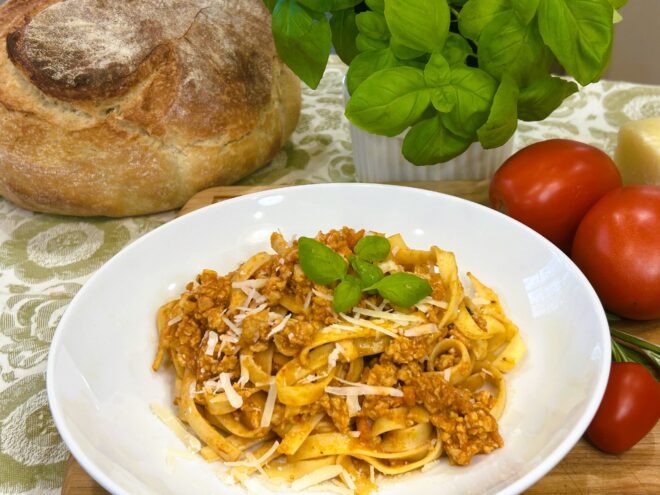
The roots of Bolognese sauce can be traced back to the city of Bologna, nestled in the heart of Emilia-Romagna. Bolognese is a hearty meat sauce most often made with finely ground beef, veal, and/or pork, along with chopped vegetables, simmered for hours in a rich tomato sauce. The rich meat sauce is most often served with handmade pasta, such as fettucine or pappardelle.
This recipe is a lighter version of the traditional Bolognese, using ground chicken and a shortcut of prepared Italian pasta sauce. Much easier to make and to enjoy on a weeknight.
Place a large Dutch oven pan over medium heat, adding in the olive oil. When the oil is hot, add in the chopped onion, leeks, and carrots, seasoning with 1/2 teaspoon salt. Cook until the vegetables are softened but have no brown color, about 5 minutes.
Add in the ground chicken, plus 1 teaspoon salt, breaking up the chicken stirring to mix in with the vegetables. Cook for about 5 minutes, stirring and breaking up the chicken into small bits combining with the vegetables. Stir in the tomato paste, cooking for 2minutes. Add in the wine, cooking and stirring until the wine is mostly evaporated. Add in the milk plus 1/2 teaspoon salt, stirring to combine. Stir in the pasta sauce, heating through, then reduce the heat to medium-low and simmer for 30 minutes. Turn off the heat, stir in 1/2 cup Parmesan cheese.
While the Bolognese sauce is simmering, prepare the pasta according to package directions. Before draining, reserve 1 cup of pasta water setting aside. Add the drained pasta to the Bolognese sauce, plus a few tablespoons of pasta water, tossing to coat the pasta with the meat sauce. Serve with additional Parmesan cheese, fresh basil,and olive oil.
Featured Market Ingredients
Cindy Ramsey has been leading cooking classes since 2012 with a focus on using seasonal ingredients, often partnering with local Farmer’s Markets. She specializes in developing classes that encourage students to have fun in the kitchen while they grow their confidence and expand their cooking and baking skills. Cindy is founder, author, and photographer of the food blog, Cooking with Chez Cindy where she publishes her own recipes and food-related stories.
“Cooking fills my days with joy—whether cooking for a client, preparing for a class, or feeding myself, my friends or my family. If I’m not cooking or baking, I’m generally thinking about the next thing I will be cooking or baking.” Cindy Ramsey
CAKE:
GANACHE:
To Make the Cake:
Preheat the oven to 350 degrees.
Spray an 8 or 9-inch round cake pan with baking spray. Whisk together flour, cocoa powder, baking soda, and kosher salt in a medium bowl.
Place granulated sugar, egg, and melted butter in a mixing bowl and beat on medium speed for about 2 minutes until pale. Add 1 cup wine and vanilla and mix to combine. Add flour mixture and mix until completely combined.
Scrape batter into prepared pan, and smooth top. Bake until a toothpick inserted in the center comes out clean, 45 to 55 minutes. Let the cake cool completely.
To Make the Ganache:
Place chopped chocolate, diced butter, and corn syrup in a large microwave-safe bowl. Microwave at high in 20-second intervals until melted, stirring between intervals until smooth. Stir in powdered sugar and 2 tablespoons of wine. Let stand at room temperature until slightly thickened, about 15-20 minutes.
Invert cake onto a plate. Pour ganache onto the center of the top of the cake letting it drip down the sides. Sprinkle with flaky sea salt, and let stand until ganache is set, about 30 minutes. Cut into wedges and serve.
This recipe is featured in our Creative Cooking with Wine Cooking Class. View upcoming classes here.
Recipe: Joyce Conway
Photo: Cindy Ramsey
Chocolate and red wine have long been a match made in heaven. Or in this recipe, a match made in Italy. This scrumptious cake is rich in chocolate flavor, but not overly sweet as the sugar is balanced by adding red wine to the batter. The cake is then glazed with a silky red wine chocolate ganache that gently dips down the sides of this single layer cake. Be sure to use the flakey sea salt sprinkled on top of the glaze as the salt acts as a bridge between the sweetness of the cake and a beautiful glass of red wine. Our wine shop recommends pairing the cake with Nebbiolo wine to complement a delightful Italian dinner. Learn how to make this cake, and more Italian favorites using wine, in our upcoming class, Creative Cooking with Wine.